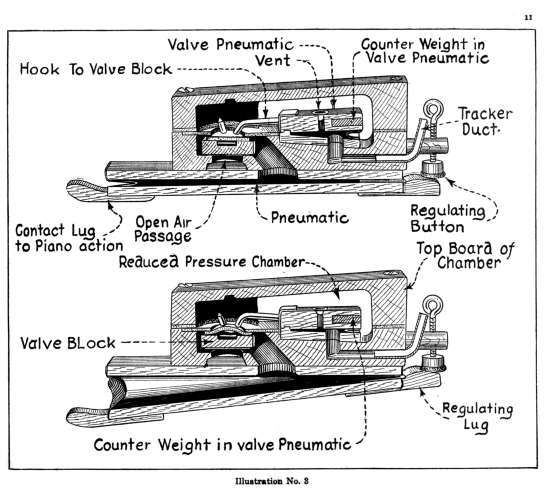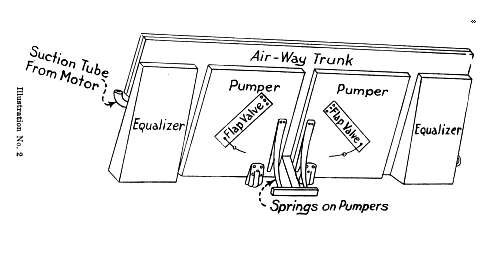| You Are Not Logged In | Login/Get New Account |
|
Please Log In. Accounts are free!
Logged In users are granted additional features including a more current version of the Archives and a simplified process for submitting articles. |
|
MMD
 Tech
Tech
 mSchulz1
mSchulz1
|
|
courtesy Gary Stevenson page 9 See Illustration No. 3, on page 11.
The unit consists of a pneumatic, or small bellows, contacting the piano action, on top of which is placed a valve block which, when it is pressed down (see upper illustration), shuts off the open air from the pneumatic and connects it with the reduced pressure chamber. When the valve block is up (see lower illustration) it shuts off the reduced-pressure chamber and allows air to enter the pneumatic. In the first case, the pneumatic collapses, because the pressure of the air outside its moving wall overbalances the reduced pressure of the air inside the pneumatic, said reduction taking place when the air in the pneumatic flows out into the reduced pressure chamber, until the pressures in the two places are balanced. It is understood in these explanations that the bellows are working, and that therefore the air is being sucked out from the reduced pressure chamber all the time. It is the motion of the pneumatic's moving wall, in the process of closing, which operates the piano action (see illustration No. 4 again). The valve block is caused to assume either the up or down position by the small "valve pneumatic." This is an exclusive Schulz feature and is considered superior to all forms of disk valve, owing to its greater flexibility of action and more rapid movements. It is caused to operate in the following manner: Suppose the pneumatic at rest, as in the lower illustration opposite. The tracker duct is, therefore, sealed at the tracker end by the paper of the music roll. Note the little "vent," or small pierced cup, running into the interior of the valve pneumatic. When the bellows are being worked there is a partial vacuum; that is, a state of reduced air pressure (thin air) in the chamber. Therefore, the air in the tracker duct and interior of the valve pneumatic flows out into the chamber through the vent, till the ... [end of page 9]
Illustration 3 at high-resolution: mschulz3.gif
(105 kb, 300 dpi, 7.34 x 6.6 inches)
04 April 2002 |
|
|
|
|
|
|
|
|
|
CONTACT FORM: Click HERE to write to the editor, or to post a message about Mechanical Musical Instruments to the MMD Unless otherwise noted, all opinions are those of the individual authors and may not represent those of the editors. Compilation copyright 1995-2026 by Jody Kravitz. Please read our Republication Policy before copying information from or creating links to this web site. Click HERE to contact the webmaster regarding problems with the website. |
|
|
||||||
|
 This
is the foundation of the pneumatic stack, and is the operating unit, one
of which actuates each section of the piano action. As shown in illustration
No. 4, page 9, the pneumatics are arranged in three banks, each bank furnished
with an interconnecting reduced-pressure chamber. All three chambers
connect by a suction tube with each other and with the bellows system.
This
is the foundation of the pneumatic stack, and is the operating unit, one
of which actuates each section of the piano action. As shown in illustration
No. 4, page 9, the pneumatics are arranged in three banks, each bank furnished
with an interconnecting reduced-pressure chamber. All three chambers
connect by a suction tube with each other and with the bellows system.
